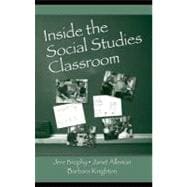
Note: Supplemental materials are not guaranteed with Rental or Used book purchases.
Purchase Benefits
What is included with this book?
| @contents: Selected Contents | |
| Introduction | |
| Need for Improving Primary Social Studies | |
| Our Partnership | |
| Searching for a Feasible Method | |
| Barbara Joins the Team | |
| Negotiating Understandings and Inducing Principles | |
| Focus of the Book | |
| Prior Research on Primary Social Studies | |
| The Need for a Powerful Content Base In Early Social Studies | |
| The Expanding Communities Sequence | |
| Cultural Universals as Unit Topics | |
| Teaching Cultural Universals for Understanding, Appreciation, and Life Application | |
| Topical Organization of Curriculum | |
| Teaching for Conceptual Change | |
| Addressing Prior Knowledge and Misconceptions | |
| NCSS Standards | |
| Other Research | |
| Generic Aspects of our Instructional Units | |
| Our Approach Compared to Alternatives | |
| Developing the Unit Plans | |
| Sequencing the Lessons | |
| Pilot Testing and Revisions | |
| Key Characteristics of the Units | |
| Example Unit Outline: Shelter | |
| Incorporating the Units Within the Larger Curriculum | |
| Using Narrative to Build a Content Base | |
| The Special Challenges of Teaching Young Children | |
| Narrative Structures as Teaching Tools | |
| Barbara's Use of Narrative | |
| Clothing in the Past | |
| The Story of Bananas | |
| Concluding Observations | |
| Structuring the Curriculum Around Big Ideas | |
| Focus on Powerful Ideas | |
| Three Layers of Powerful Ideas for Teaching | |
| Barbara's Focus on Big Ideas | |
| Maintaining Focus on Big Ideas without Getting Sidetracked | |
| Techniques for Focusing Students' Attention on Big Ideas | |
| Cultural Universals | |
| Food | |
| Clothing | |
| Transportation | |
| Communication | |
| Developing Big Ideas About History | |
| Teaching History for Understanding, Appreciation, and Life Application | |
| Barbara's History Teaching | |
| Countering Presentism | |
| Co-constructing Timelines | |
| An Example | |
| Adapting Timelines to the Content | |
| Developing Big Ideas: Geography | |
| The Five Fundamental Themes of Geography | |
| NCSS Standards Relating to Geography | |
| Teaching Geography for Understanding, Appreciation, and Life Application | |
| Barbara's Geography Teaching | |
| A Map Lesson | |
| Incorporating Geographic Context Into Other Lessons | |
| Developing Big Ideas: The Social Sciences | |
| Anthropology (Cultural Studies)Barbara's Teaching About Culture | |
| Economic Development | |
| Cultural Differences | |
| Economics | |
| Barbara's Teaching About Economics | |
| Political Science (Civics and Government)Barbara's Teaching About Civics and Government | |
| Using Instructional Resources | |
| Teaching with Visuals | |
| Books | |
| Photos and Illustrations | |
| Video and Other Technology | |
| Constructed Learning Resources | |
| Charts | |
| Lists | |
| An Example | |
| Word Webs | |
| Graphs | |
| Barbara's Nine Principles | |
| Making Connections and Avoiding Undesired Content | |
| Making Connections | |
| Foreshadowing | |
| Tie-backs | |
| Integrating Across Subjects | |
| Controlling Students' Exposure to Anomalies and Misconceptions | |
| Anomalies | |
| Misconceptions | |
| Controlling Students' Exposure to Undesired Content | |
| Economic Disparities | |
| Taboo Topics | |
| Negative Emotions | |
| Magic Words | |
| Developing Big Ideas | |
| Introducing New Knowledge Bases | |
| Adapting and Elaborating Lesson Plans | |
| Choosing Physical Settings | |
| Choosing Instructional Resources | |
| Developing Skills | |
| Starting by Eliciting Wonders | |
| Establishing the Initial Knowledge Base | |
| Starting with the Prototypical | |
| Building on Prior Knowledge | |
| An Example | |
| Alternative Topic Introductions | |
| Building on Previous Lessons | |
| Starting with a Question | |
| Addressing Strong Interests First | |
| Purposeful Sets of Examples | |
| Introducing and Controlling Vocabulary | |
| Deciding Which Terms and Distinctions to Teach | |
| Tailoring Definitions to Instructional Goals | |
| Enriching Understandings | |
| Planned Redundancy | |
| Other Vocabulary Teaching Techniques | |
| Dropping in Definitions and Explanations on the Fly | |
| Developing Knowledge Bases Through Structured Discourse | |
| Supporting Learning Through Focused Content and Planned Redundancy | |
| Sustaining Lesson Flow via Elaborations | |
| Graduated Questioning | |
| Scaffolding Learning and Retention | |
| Establishing Prototype Images to Anchor Networks of Content | |
| Reviewing Earlier Lessons to Set Up Today's Lesson | |
| Reviewing to Consolidate Before Moving Forward | |
| Modeling of Interio | |
| Table of Contents provided by Publisher. All Rights Reserved. |
The New copy of this book will include any supplemental materials advertised. Please check the title of the book to determine if it should include any access cards, study guides, lab manuals, CDs, etc.
The Used, Rental and eBook copies of this book are not guaranteed to include any supplemental materials. Typically, only the book itself is included. This is true even if the title states it includes any access cards, study guides, lab manuals, CDs, etc.